#Properties Norwich
Explore tagged Tumblr posts
Text

#disaster restoration binghamton#property restoration broome county#licensed mold removal cooperstown#mold remediation binghamton ny#water damage remediation binghamton#demolition contractors binghamton ny#mold remediation contractor norwich
0 notes
Text

Emergency call out - Clearance & Removal available
#recycling#recycle#charity#evicted#scrap metal#warehouse storage#storage solutions#storage#house#house removal#house clearance#clearing#clearance#land clearance#property clearance#land removal#suffolk#norfolk#essex#london#cambridge#ipswich#norwich#colchester#framingham#woodbridge
0 notes
Text
𝐓𝐡𝐞 𝐓𝐫𝐨𝐮𝐛𝐥𝐞𝐝 𝐇𝐢𝐬𝐭𝐨𝐫𝐲 𝐨𝐟 𝐂𝐡𝐫𝐢𝐬𝐭𝐢𝐚𝐧 𝐏𝐞𝐫𝐬𝐞𝐜𝐮𝐭𝐢𝐨𝐧 𝐨𝐟 𝐉𝐞𝐰𝐬.
I'm sick and tired of Candace Owens and her likes that are obsessed with framing Jews behind every problem that they had over the years. While we all love the Christians and while most Christians are real friends of the Jews, I think this has to be said again and again. So let's review some history and some facts.

1/ Early Christian Era:
Hostility towards Jews began as early as the 4th century when Christianity became the Roman Empire's official religion. Emperor Constantine's policies, later codified in the Theodosian Code, restricted Jewish rights. Jews were barred from public office, synagogues were destroyed, This set a precedent for future Christian rulers to marginalize Jews.

2/ First Crusade (1096):
As the Crusaders marched to the Holy Land, they massacred Jewish communities in the Rhineland (modern-day Germany). Known as the Rhineland massacres, thousands of Jews were killed in cities like Worms, Mainz, and Cologne. The violence was often enabled by Crusader preachers who framed Jews as enemies of Christianity. Many Jews chose martyrdom over forced conversion, a theme that would reappear in later persecutions.

3/ Blood Libel Accusations (12th century - today):
The first known case of blood libel occurred in Norwich, England, in 1144, when Jews were falsely accused of murdering a Christian boy, William of Norwich, for ritual purposes. These accusations led to widespread violence and massacres, including notable cases in Trent (1475) and Damascus (1840). Blood libel myths fueled antisemitism, resulting in the torture, execution, and expulsion of Jews across Europe.
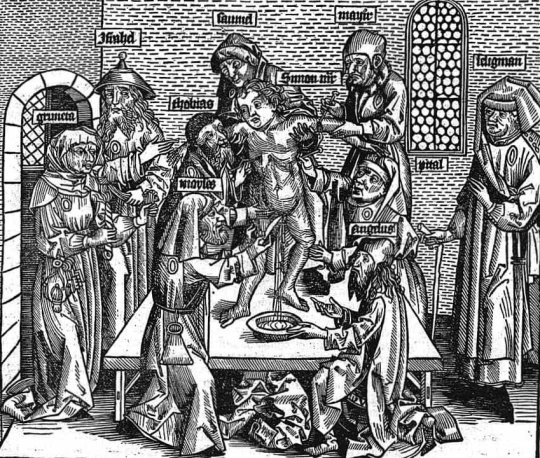
4/ The Black Death (1348-1351):
As the plague ravaged Europe, killing millions, Jews were scapegoated and accused of poisoning wells. Pogroms erupted across the continent, with entire Jewish communities in cities like Strasbourg being annihilated. In some areas, Jews were burned alive, while in others, they were forcibly converted or expelled. Despite papal condemnations of the violence, local authorities and priests encouraged and some even participated in the massacres.

5/ Spanish Inquisition (1478-1834):
The Inquisition targeted conversos, Jews who had converted to Christianity, suspecting them of secretly practicing Judaism. Tomas de Torquemada, the first Grand Inquisitor, led a brutal campaign of torture and execution. The Alhambra Decree of 1492, issued by Ferdinand and Isabella, expelled all Jews from Spain, forcing over 200,000 to convert or flee. This expulsion ended centuries of Jewish cultural and intellectual contributions to Spain.

6/ Expulsions in Europe:
Over centuries, Jews faced expulsion from numerous European countries. England (1290) saw the Edict of Expulsion under King Edward I, forcing Jews to leave and seizing their property. France (1306 and 1394) saw similar expulsions, as did various German states. These expulsions often followed periods of economic exploitation and violence against Jews, stripping them of property and wealth and forcing them into exile.

7/ Ghettos and Restrictions (16th-18th centuries):
In many European cities, Jews were confined to ghettos, segregated neighborhoods with curfews and restricted economic opportunities. The first ghetto was established in Venice in 1516. In Rome, Pope Paul IV established the Roman Ghetto in 1555, enforcing strict segregation. Jews in ghettos faced overcrowding, poverty, and social isolation, with limited rights and constant threat of violence.

8/ Russian Pogroms (19th-20th centuries):
The assassination of Tsar Alexander II in 1881 sparked a wave of violent pogroms against Jews across the Russian Empire. These state-sanctioned attacks involved looting, arson, and murder, with entire villages destroyed. The May Laws of 1882 further restricted Jewish rights, driving mass emigration to the United States and Israel. Pogroms continued into the early 20th century, culminating in the Kishinev Pogrom of 1903, these pogroms were influenced by various social, economic, and political factors, they occurred in a predominantly Christian society where antisemitic attitudes were pervasive and pushed by local priests, and a lot of Christians participated in the violence.
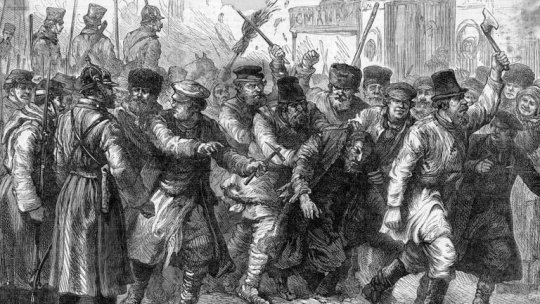
9/ Context on Christian Persecution Claims:
While millions of Christians have faced persecution over the years, those claiming they are the most persecuted group are misleading. Let’s look at some numbers:
- 1800: Approximately 22% of the world population was Christian, around 200 million out of 900 million.
- 1850: Christians made up about 28% of the world population, roughly 350 million out of 1.2 billion.
- 1900: The proportion increased to 34%, with 560 million Christians out of 1.65 billion people globally.
- 1950: Christians constituted about 35% of the global population, approximately 800 million out of 2.3 billion.
Today, around 31% of the world's population identifies as Christian, approximately 2.3 billion people out of 7.8 billion. Given these numbers, it's clear that while Christians have certainly faced persecution, the idea that they are the most persecuted group does not hold up. It's like saying the world is the most persecuted world—statistically inaccurate given the substantial and growing global Christian population.
This context does not diminish the real suffering that many Christians have endured, especially in certain regions and periods. However, the Jewish experience of persecution stands apart due to its intensity, persistence, and the often racially motivated nature of the oppression. Jews, a much smaller group historically, have faced systemic efforts aimed at their complete eradication, from medieval pogroms to the Holocaust. Their persecution involved not just religious but also racial and cultural dimensions, leading to centuries of marginalization, violence, and genocide.
10/ Conclusion:
The history of Christian persecution of Jews is a strong reminder of the consequences of intolerance and bigotry. While it's important to acknowledge and appreciate the many Christians who have stood by Jews as true friends, we cannot ignore the dark chapters where Christian societies and authorities played a significant role in the suffering of Jewish communities.
By understanding these historical contexts, we can better appreciate the resilience of the Jewish people and the importance of standing against all forms of hatred. Let's ensure that history does not repeat itself by fostering an inclusive and compassionate future. It's time to move beyond misplaced blame and work together to combat antisemitism and bigotry in all its forms...
𝐋𝐞𝐭’𝐬 𝐟𝐨𝐜𝐮𝐬 𝐨𝐧 𝐰𝐡𝐚𝐭 𝐭𝐫𝐮𝐥𝐲 𝐮𝐧𝐢𝐭𝐞𝐬 𝐮𝐬: 𝐨𝐮𝐫 𝐬𝐡𝐚𝐫𝐞𝐝 𝐡𝐮𝐦𝐚𝐧𝐢𝐭𝐲 𝐚𝐧𝐝 𝐨𝐮𝐫 𝐜𝐨𝐦𝐦𝐨𝐧 𝐠𝐨𝐚𝐥 𝐨𝐟 𝐡𝐚𝐩𝐩𝐢𝐧𝐞𝐬𝐬 𝐚𝐧𝐝 𝐟𝐮𝐥𝐟𝐢𝐥𝐥𝐦𝐞𝐧𝐭.

37 notes
·
View notes
Note
🌈 + and OC of your choice <3

John Welles. Earl of Norwich. parcere subiectis et debellare superbos [spare the subjects, wage war against the proud]
such a beautiful boy - my sweet antinous, you were meant to lay against me, wrapped in nothing but fine silks
He’s intelligent, handsome, a dashing spy and courtier. Cultured, witty and well read. The perfect renaissance man, much enamoured of the Empire of Rome. The Duke of Norfolk’s trusted agent and friend. A monster and a gentleman.
John Norwich is one of my Tudors OT3 verse OCs. He respects one (1) of these fuckers and that’s the Duke of Norfolk. He would love the dark academia classics aesthetic. He has plans within plans. He’s the monster haunting Thomas Cromwell’s nightmares, who took him age ten and never wanted to let go.
When he finds ‘his antinous’ at court, a favourite of the monarchs and as beautiful a man as he was as a child (to Norwich) he is determined to reclaim him. For is he not his slave, his property after all.
with so much thanks to @lemurious for giving me Norwich’s latin motto and @nocompromise-noregrets for being a friend and plotting partner <33333.
13 notes
·
View notes
Text
Because I’ve got my finger right on the pulse, I’m gonna make a meandering post about a long-cancelled period drama rather than the major one currently airing. But this has been in the drafts for ages, and yeah I just really didnt like the depiction of Kett’s rebellion in Becoming Elizabeth. And I need to complain about it lol. I wish i could say it was a good effort but im not sure i can even give it that...
a looong post because i cannae haud me wheesht
Firstly, and perhaps one of the most important things, is they have the rebels in the show rally around the cry, ‘kill all gentlemen!’ This wasn't a phrase used by the rebels at the Mousehold camp - it's been attributed to the revolts in the West, but i'd agree with recent research that it doesn't seem to actually have been said by anyone. The sentiment in of itself - the tearing down of the elite class - isn't something expressed in the articles the rebels produced, even if there were underlying tensions between the two groups. You do see it appear in individual testimonies sometimes, like here:
'the pore peple are now Famysshed but C of us wyll rise one daye agenst them & I wylbe one day he'.
I'm also not saying they were nice to the gentlemen they captured, or that they didn't want to confront these landed elites, because they did. But the rebels weren't, as shown in BE, slitting the throats of random nobles they came across. That kind of indiscriminate, murderous loathing isn't something i've seen represented in the sources describing their actions. There were few murders at all committed by the rebels - the battles against crown forces excluded - and fewer still can be confirmed to have been gentry. (although i should point out, whilst I'm focusing on Norwich because the show did, iirc there were killings of elites, and more talk in that sort of vein, in yorkshire). In the south, their violence seems largely to have been aimed at property, and chosen enclosures/deer parks and houses/household goods. that was the consistent thread running through their physical responses. For example:
'So some of the common people rose in Kent, Surrey, and Sussex under a captain they called Common-wealth and made havoc on the wild beasts in many of the parks in these parts. But they paid for their food in every place'.
or,
'they have pluckyd downe Sir Wyllyam Harberde’s parke that ys abowte hys newe howse, and dyverse other parkysse and commonse that be inclosyd in that cuntre, but harme thay doo too parson (nobody).... They saye thay wylle obaye the Kynges maiste and my lord Protector with alle the counselle, but thay saye thaye wyll nat have ther commonse and ther growendes to be inclosyd and soo taken from them.'
and from Holinshed,
'ditches and hedges, wherewith the commons abrode in the countrie were inclosed, were throwne downe'
Their violence was a response to land, economic, religious, as well as highly local factors. To my understanding, it didn't represent a desire to either kill or eradicate gentlemen as a social group. The Norwich articles do suggest aims to minimise their interference in the community, and it did represent a radical restructuring of local rights and spheres of influence - at least, as i understand it.
Again, all this isn't to say there wasn't force, that there wasn't any brutality, or that there wasn't bitterness or resentment directed at elites. To take another example from Holinshed, he describes this killing of an Italian mercenary at Mousehold:
‘but they [Dudley's forces] left one of their companie behind them, a gentleman that was an Italian, who… through euill hap being outherthrowne beside his horsse, he was inuironed about with a great multitude if those rebels, that tooke him prisoner, and like vile wretches spoiling him of his armor and apparell, hanged him ouer the wals of mount Surrie. Which act shewed what courtesie might be looked for at such cruell traitors hands… it seemed that their beastlie crueltie had bereft them the rememberance of all honest consideration and dutifull humanitie’.
Having said that, the way the show presents the rebels' violence seems to me to be unrepresentative. BE depicts an overly simplistic picture of the commons indiscriminately murdering nobles w/o compunction or for any particularly complex reasons. Just, showing these people yanking a random man and woman off their horses to slit their throats and then leaving them to die... it really fucked me off. That is not at all accurate to events or the commons' behaviour during Kett's rebellion. At least, not in any sources that i've read. I mean funnily enough people werent too keen on getting hanged, which goes a long way to explaining why they skewed away from interpersonal violence.
The show also understates the sheer scale of the death toll imo. Not only were significant numbers killed at Dussindale, but a large number were executed after the fact. There was also battles near Exeter, and a great many Cornish were killed - I've come across the number as potentially as many as 2 000 before.
'The knight, hearing of this came with 200 men in harness who by his order attacked the commons and slaughtered them like wolves among sheep'
'During this time the Lord Privy Seal saw his opportunity to attack the besiegers [at exeter] before the Cornishmen arrived and killed more than 5,000. ....Then [at Norwich] the captain and many honest men were hanged, many of them without deserving it for any harm they had done, and some who had not even raised a stick to go to the field'
i don't think the figures have to be understood as being 100% accurate to nevertheless impart the sense of scale.
BE sort of glosses over this, even if it shows a handful of rebel leaders being hanged. Local communities such as Norwich, Yarmouth and others involved would have been greatly effected in terms of the proportion of their population who were now dead.
And the number of people hanged, drawn, and quartered at the market cross in norwich.. it was 30 or so i think? i can't imagine watching all those people be brutally killed on the same spot in one day. There were churchmen hanged from their steeples in various towns (oh how funnily ironic of you!) - this also extended to William, Robert Kett's brother,
'likewise hanged on the toppe of Windham [Wymondham] Steeple'
And, ofc, people's hung, drawn and quartered body parts were placed on the town/city gates. There were hangings in many local areas wherever support for the rebellion had existed.
Rebels were also hanged actually from the oak of reformation, which I’d argue is a fairly pointed inversion and disregard for such a key symbol of the revolt. It strikes me as particularly cruel and dismissive. as in, everything they tried to convey about themselves was shown to be utterly pointless and irrelevant.
memories of all this lasted, as you can imagine, for decades afterwards, like in 1596:
'the people that there [oxfordshire] did Rise were persuaded to goe home, and were after hanged like dogges'
This deficit in the show is seemingly symptomatic of the general under-representation of the sheer scale of what was happening. the number of amassed people shown is miniscule compared not only to the numbers at Mousehold but also those across the south - as well as some disturbances in the north. I feel like this couldve been mentioned in the dialogue since showing all that wouldve been very difficult, as the scale was most likely a budget thing. But showing merely the killing of Kett and a handful of others does the whole sequence of events a terrible disservice.
It also glosses over the extent to which this was a factor in Somerset's fall, and it was a big factor. The nobility felt he was prioritising the commons over their own interest. Paulet wrote in a pretty exasperated way about Somerset’s policies, and ofc Warwick grew increasingly impatient with him. The common people actually rose in decent numbers when he asked them, but Seymour turned them away in the end. I think he likely realised it was a bridge too far. Edward was actually allowed to survive for a short time after the risings, but not by much.
Anyway, overall i felt the show was far too harsh towards the rebels and presented them as very one-dimensional. And on the flip-side if anything it was too kind towards the nobility in its depictions of their response, considering they showed only a few hangings and not the overwhelming scale of death and brutality that followed. It’s been a while since I’ve watched the show, but did they mention the battle at mousehold, even? If not I think that’s diabolical
(As an aside to that last point, I do find John Dudley interesting. And I mention that because I want to be clear, I’m not saying you can’t like these people, or find them fascinating or compelling or moving. But when ‘these people’ are Tudor ministers you have to be prepared that they will have done some terrible things. Whether that behaviour is the ‘norm’ then or not, it still makes for difficult, upsetting reading. And I’m saying this as someone who does find the characters of these v competent/influential ministers really fascinating - like Wolsey, Cromwell, Cranmer, Dudley, Cecil etc. I mean, Cecil in the wake of the northern revolt? Reading those documents makes me feel a bit sick actually. It’s chilling. But anyway, anyone in the court can come under this umbrella to varying extents, but the drivers/orchestrators of policy are obviously - next to the monarchs - at the heart of any brutality…)
#i get it. it’s a show about young Elizabeth#so if there wasn’t time to depict this properly. they’d have been better off sticking to her perspective. or a court perspective anyway#because… there’s not much to commend the portrayal of it#it's just a shame that one of the fleeting glimpses of popular culture afforded in a tudor drama was clearly not given the research needed#like. not even by half#this is a brief whistlestop tour. there's more that could be said and a lot more sources to include. but this is long enough as it is!#period drama#becoming elizabeth#the Tudors#john dudley#edward seymour#kett’s rebellion
8 notes
·
View notes
Text

Ruth Wyner
Charity worker with the homeless whose imprisonment under the Misuse of Drugs Act caused an international outcry
In 1998, at the peak of Ruth Wyner’s career as a manager of bold and innovative projects to help homeless people, a crowd of police officers clattered up the narrow stairs of the Wintercomfort day centre in Cambridge, squeezed into Ruth’s attic office and announced that they had arrested eight of her “clients” for dealing drugs.
“Excellent. Well done,” said Ruth. She was well-known for her anti-drugs stance; her anti-drugs policy, developed in cooperation with the police, was considered a model of good practice.
“We’re also arresting you,” said the police, “for knowingly allowing the distribution of a class A drug on the charity premises.”
The arrest, and Ruth’s subsequent imprisonment, provoked an international outcry, and ended the career of one of the most effective charity workers for homeless people.
Ruth, who has died aged 74, was a formidable campaigner for social justice and, following her release from prison in 2000, changed career and became a trailblazer in group therapy. Her life was marked by resilience, creativity and a commitment to helping those most in need.

Born in London, Ruth was the daughter of Anna (nee Nagley), a mosaic artist, and Percy Wyner, a hero of the Burma campaign who later became a cloth merchant. She attended St Paul’s girls’ school in west London, where she excelled at 100-metres hurdle and being troublesome. On leaving St Paul’s in 1968, she launched herself into hippy life with glee.
She edited one of the alternative magazines launched by John “Hoppy” Hopkins, became a local journalist, moved to Norwich, joined the band Crazy Lizard as songwriter, singer and synthesiser player, and moved in with the lead guitarist, Gordon Bell, her future husband. Crazy Lizard started with a benefit night for the homeless, “went off like a firework for a year” and ended with a “crazy, amazing” gig in a snowstorm at the end of Hastings pier.
For six years, Ruth and Gordon took over a deserted bungalow in a piece of industrial wasteland. After the birth of their first child, Joel, they got a friend to install electricity. “He went round hitting things until the lights came on. He didn’t know how he did it either.” When property developers started to sniff about, Ruth negotiated her first major fundraising deal: £1,000 to leave immediately. She used it as a deposit for a house, in time for the birth of a daughter, Rachel.
It was while she was in Norwich that Ruth’s younger brother killed himself by jumping from the window of a London homeless hostel. She rarely talked about this incident, but turned her despair into action. She began working overnight shifts in a “Dickensian” church, St Martin at Oak, supervising up to 40 homeless women and men facing addiction, mental health problems and poverty, eventually becoming the manager, then deputy director of the St Martins Housing Trust charity. Next, in Great Yarmouth, she set up, in the space of a single year, a new direct access hostel for the homeless.
With a reputation for bold thinking, quick action and brilliant campaign work, she was headhunted by Wintercomfort, a homelessness charity that operated out of an old bus in a Cambridge car park. Within three years she had moved premises to a four-storey converted dancing school overlooking the river and set up a highly efficient day centre, a winter night shelter and an outreach team.
Every day, between 70 and 120 people used the service: many drug addicts, more alcoholics, a good number of the mentally ill, many driven to the streets by mental or physical abuse, or grief. Ruth believed that homelessness has little to do with not having a house; that is the final, comparatively minor symptom of something that has gone profoundly wrong in a person’s life.
Ruth’s genius was to be able to negotiate a turbulent boundary of scales: on the one side, the large, generalising sweep of government-driven policy and the demands of law enforcement; on the other, the small, legally hazy dramas of the homeless. Because Ruth was able to remain professional and strong in this clash of contrary forces – negotiating, for example, a £400,000 deal for a new, alcohol-free night shelter with the city council, then hurrying back to the day centre to talk an alcoholic client out of taking her own life in the centre’s toilets – she lessened the misery of thousands and saved many lives.
Shortly after the news broke that the new night shelter was to be built next to a wealthy residential neighbourhood, the police installed a hidden camera in the roof of Jesus College rowing club, across the street from Wintercomfort and, following 300 hours of recording, confirmed eight heroin deals in the charity grounds.
The judge at the trial said that there was no evidence Ruth had encouraged or benefited from the drug dealing at the charity, only that she had not agreed with police on the best way to stop it taking place, and refused to hand over the charity’s list of banned users, on grounds of confidentiality. He sentenced Ruth to five years in prison.
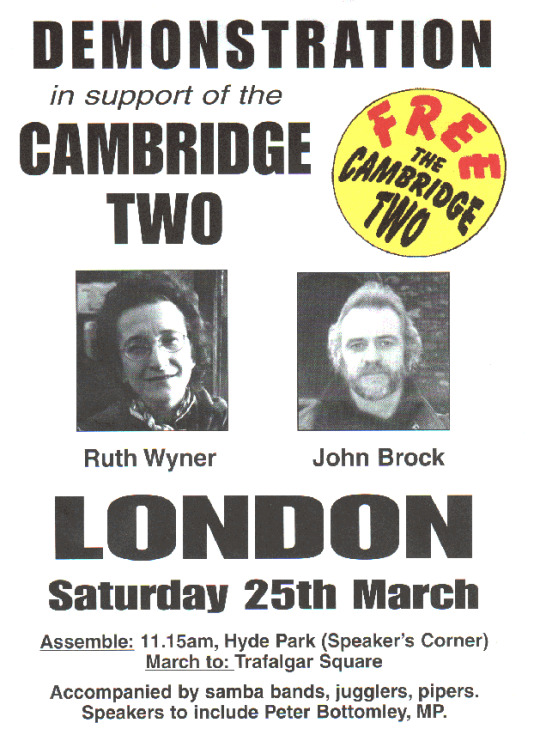
Prison did not break Ruth. She adapted quickly. She learned the prison “slow walk”, developed an unexpected interest in violent films (which vanished on release), became a prison gardener, and started a book about life behind bars, From the Inside (2003). By the time her sentence was reduced to time served on appeal, she had breast cancer.
“Group therapy saved me,” Ruth said.
After her release, and recovery, Ruth travelled to China, India and Canada; she became a tai chi instructor, and trained as a group analyst at the Turvey Centre near Bedford. With its focus on both the individual and the wider community, group analysis perfectly suited Ruth’s extraordinary abilities as a communicator and guide.
For 17 years she worked at the Cambridge Group Therapy Centre, including as the clinical lead 2011-18.
Once again, she embraced inclusivity and openness. Unlike other group therapy practices, she refused to turn people away if they were drug addicts, or chaotic and traumatised; she welcomed them.
She is survived by Gordon, whom she married in 1978, Joel and Rachel, and a grandson, Kaio.
🔔 Ruth Avril Wyner, charity worker and group therapist, born 1 April 1950; died 29 December 2024
Daily inspiration. Discover more photos at Just for Books…?
6 notes
·
View notes
Text
ON THIS DAY - 07 December 1549
On This Day (07 Dec) in 1549, Robert Kett, the leader of 'Kett's Rebellion', and his brother William Kett were executed in Norfolk.

In the summer of 1549, local peasants and farmers, in response to land enclosures, which had led to eviction from land and property and a monopoly on land by a small number of owners, started to revolt. They were led by Robert Kett, a wealthy Norwich multi-generational farmer. One of the first targeted landowners was Sir John Flowerdew, brother-in-law of 17yo Amy Robsart.
An army of 1400 men was sent by Edward Seymour, Edward VI's Lord Protector, led by William Parr, Marquess of Northampton, to quell in Jul 1549, but had been defeated, with the rebels were gaining increasing local support. In Aug 1549, further military support of 14000 men, led by John Dudley, Earl of Warwick, was therefore sent to Norfolk.

Dudley took with him two of his sons, Ambrose and Robert, this being their first exposure of 'warfare'. On their arrival in Norfolk, Dudley and his sons lodged at the home of Sir John Robsart (another targeted landowner) in Wymondham, with the army encamped on his lands. Joined by Northampton, Dudley and his army entered Norwich on 24 Aug, and fighting took place over the next few days, culminating in the final battle on 27 Aug, where 3000 rebels lost their lives.
In the immediate aftermath of the rebellion, captured prisoners were tried and executed; it was said that 49 prisoners were hanged at Norwich. However, around the same amount were released and pardoned the following year.
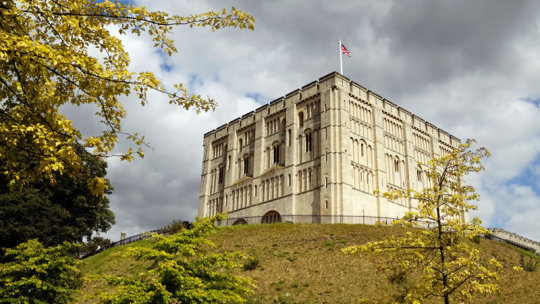
Following their arrests, the Kett brothers were taken to London, and held at the Tower of London. They stood trial at Westminster Hall on 26 Nov 1549, where they were found guilty of treason, by inciting 'sedition, rebellion, and insurrection' and were sentenced to death. They were consequently returned to Norfolk for their sentences to be carried out. On 07 Dec, Robert was hanged by chains from the side of Norwich Castle, whilst William was hanged from the west tower of Wymondham Abbey.
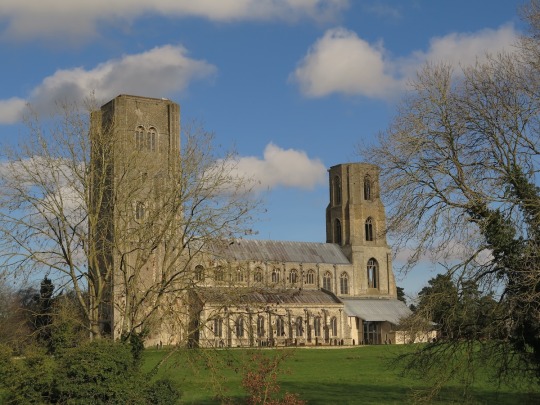
#tudor england#tudor history#history#tudor people#tudors#tudor#robert dudley#Ambrose dudley#John dudley#Amy robsart#John robsart#John flowerdew#Robert kett#William kett#norwich#norfolk#wymondham#Kett's rebellion
7 notes
·
View notes
Text
The Little Hazelnut: Made, Loved, Kept
“And in this He showed me a little thing, the quantity of a hazelnut, lying in the palm of my hand. And it was as round as any ball. I looked upon it with the eye of my understanding, and thought, 'What may this be?' And it was answered generally thus, 'It is all that is made.' I marveled how it might last, for I thought it might suddenly have fallen to nothing for littleness. And I was answered in my understanding: It lasts and ever shall, for God loves it. And so have all things their beginning by the love of God. In this little thing I saw three properties. The first is that God made it. The second that God loves it. And the third, that God keeps it.”
— Julian of Norwich, Revelations of Divine Love
7 notes
·
View notes
Photo

And in this he showed me a little thing, the quantity of a hazel nut, lying in the palm of my hand, as it seemed. And it was as round as any ball. I looked upon it with the eye of my understanding, and thought, ‘What may this be?’ And it was answered generally thus, ‘It is all that is made.’ I marveled how it might last, for I thought it might suddenly have fallen to nothing for littleness. And I was answered in my understanding: It lasts and ever shall, for God loves it. And so have all things their beginning by the love of God. In this little thing I saw three properties. The first is that God made it. The second that God loves it. And the third, that God keeps it. And in þis he shewed me a lytil thyng þe quantite of a hasyl nott. lyeng in þe pawme of my hand as it had semed. and it was as rownde as eny ball. I loked þer upon wt þe eye of my vnderstondyng. and I þought what may þis be. and it was answered generally thus. It is all þat is made. I merueled howe it myght laste. for me þought it myght sodenly haue fall to nought for lytyllhed. & I was answered in my vnderstondyng. It lastyth & euer shall for god louyth it. and so hath all thyng his begynning by þe loue of god. In this lytyll thyng I sawe thre propertees. The fyrst is. þt god made it. þe secunde is þet god louyth it. & þe þrid is. þat god kepith it. ― Julian of Norwich, Revelations of Divine Love ch v (Westminster Cathedral Treasury, MS 4)(1373)
[Robert Scott Horton]
20 notes
·
View notes
Text
Schedule demolition services in Binghamton, New York, with our contractors
Timing is of the essence when arranging demolition services in Binghamton, New York. The ideal time to schedule demolition can be determined by a number of factors, resulting in a seamless and effective procedure. Let's discuss when would be best to start your demolition project.
ideal Seasons for Demolition: In Binghamton, New York, spring and summer are usually the ideal times for demolition. There is less likelihood of rain or snow, which might impede or postpone demolition operations, and the weather is more predictable. Longer daylight hours also mean more working hours, which means contractors may do their tasks more quickly.
Availability of Demolition Contractors: The accessibility of demolition contractors in Binghamton, New York, is a crucial factor to take into account. Since spring and summer are the busiest times of year for building and demolition projects, it's best to book your demolition services well in advance to guarantee a place on the contractor's calendar.
Preventing Winter Complications: You can also prevent possible issues with freezing temperatures by planning your demolition work during certain seasons. Winter demolition projects can be particularly tough because of the frozen ground and snow accumulation, which can make the task more complex and time-consuming.
Consult with Experts: It's advisable to speak with a qualified demolition contractors binghamton ny, if your project is time-sensitive or if you have structural problems that need to be fixed right away. They are qualified to assess the circumstances and recommend the best course of action.
Thus, when you book demolition services will have a big influence on how well your project turns out. At 360 Property Restoration, we recognize the value of punctuality and dependability in demolition operations. Our skilled contractors in Binghamton, New York, are committed to offering reliable demolition services of the highest caliber. Whether you're organizing a commercial or residential demolition, we have the know-how to manage your project successfully and quickly. create an appointment for your demolition services with us right now to see the impact our team can create.
Furthermore, our Storm Damage Restoration service can assist you if storm damage has been sustained to your property. We'll put in endless effort to get your property back to its pre-storm state with timely and expert assistance, guaranteeing your safety and peace of mind. You can trust us with all of your restoration and demolition needs.
Call now!
#water damage restoration norwich#mold remediation contractor norwich#fire restoration chemung county#property restoration cortland county#water damage remediation binghamton#licensed mold removal norwich#water damage restoration elmira
0 notes
Text
Surprisingly, in view of her later attempts to persuade her nobility to relinquish monastic lands, Mary as princess apparently showed no reluctance to take possession of vacated church properties. The most significant among these was the priory of St. John of Jerusalem, which became Mary's London residence. Others included Oldehall in Essex, which had also been a priory; Epping manor in Essex, which had recently belonged to the monastery at Waltham; and the rents and pensions that had formerly been paid to the Thetford monastery in Norfolk. Through another grant in early 1553, she added to these the lands of Bungay and Norwich abbeys.
From Heads of Household to Heads of State. The Preaccession Households of Mary and Elizabeth Tudor, 1516-1558. by J.L. McIntosh.
7 notes
·
View notes
Quote
In this same time our Lord showed me a vision of his love. I saw that He is to us everything that is good and comfortable for us: He is our clothing that for love wraps us, clasps us, and all encloses us for tender love, that He may never leave us; being to us all things that are good. Also in this He showed me a little thing, the size of a hazelnut, in the palm of his hand; and it was as round as a ball. I looked upon it and thought what may this be? And the Lord answered me: “it is all that is made.” I marvelled how it might last, for I thought it might have fallen to nothingness because of its littleness. And I was answered: ‘It lasts, and ever shall last, because God loves it’. And so all things have being by the love of God. In this little thing I saw three properties: the first is that God made it, the second is that God loves it, and the third, that God keeps it.
Julian of Norwich
14 notes
·
View notes
Text
Eight Nights Of Prompts: Fic One
original post for prompts and how it works
you will never have me, not in any way that truly matters (Tudors OT3 verse for @uncheckedaggression <3.
He is not the shy boy he had been but, Norwich thinks, he is still very beautiful - that had been half the pleasure of choosing his property, to find a jewel in the refuse of London and shine it only for himself.
Thomas Cromwell as a man has a quiet competence that makes Norwich’s lip curl - he is extraordinarily close in the royal counsels and more than that he has a son. The boy, Gregory takes after his mother it seems - a woman long dead or Norwich would have killed her himself for touching his jewel, his pretty treasure - for stealing the spoils of Norwich’s labor and wasting it on offspring.
More than that, he sees Cromwells smile one day - he smiles at the King and Queen - all soft eyed sentimentality and it sickens Norwich to see.
Only as he lays his head upon a block and waits for the axe to fall does John Norwich realise what he had not seen.
26 notes
·
View notes
Text
The Seven Dog Groups Explained
The are seven different dog groups and each breed is assigned to a group based on the purpose they were originally bred for and their characteristics.
By the end of this post you will know the seven dog groups, a description of each group, and give different breeds that have been assigned to each group.
Herding Group
The herding group was first created/founded in the year 1983. The breeds in this group all have the ability to control the movement of other animals, also known as herding. When one of these breeds are household pets it is rare that they actually see or herd farm animals and because of this, their natural instinct tends to have them lightly herd their owners or the kids of the family. Though they tend to try and herd their owners, these intelligent dogs are fantastic companions and can be easily trained.
Breeds in this group include but are not limited to:
Australian Cattle Dog
Australian Shepered
Bearded Collie
Beauceron
Belgian Laekenois
Hound Group
Originally Hound dog breeds are classified and members of the Sporting group, until the year 1930, when the American Kennel Club created the hound group. Breeds that are assigned to this group all share the trait of being used for hunting. Some hound were used more intensely than others. Some use acute smelling power to track a trail while others use extraordinary stamina that they use to chase and catch quarry. Other hounds have the ability to make a very unique hunting noise called baying. Some day before getting a hound, it is better to hear the noise first.
Breeds in this group include but are not limited to:
Afghan Hound
American English Coonhound
Bassett Houjd
Beagle
American Foxhound
Toy Group
The petite and delightful style of Toy dogs represents one main duty this group has, which is to exemplify a large amount of joy. But Toy dog breeds are tough and have always been very popular when it comes to those who live in apartments or in the city.
(There are small dog breeds in each group – just because the breed is small doesn’t always mean they belong to the toy group)
Breeds in this group include but are not limited to:
Affenpinscher
Brussels Griffon
Cavalier King Charles Spaniel
Chihuahua
Chinese Crested
Non-sporting Group
There really isn’t much to say about the non-sporting group except for all the breeds assigned to this group have a high variety of size, coats, personality, and their overall appearance.
Breeds in this group include but are not limited to:
Boston Terrier
Bulldog
Dalmatian
Chow Chow
American Eskimo Dog
Sporting Group
The Sporting Group includes pointers, retrievers, setters, and spaniel breeds which all are extremely active and are always on high alert. They have outstanding instinct when it comes to hunting and other field activities that still to this day, they participate in such activities.
Breeds in this group include but are not limited to:
Cocker Spaniel
English Setter
German-Shorthaired Pointer
Golden Retriever
Brittany
Terrier Group
Terrier’s vary in size – from target smash breeds to large breeds. Most people already know how the Terrier personality is: courageous with a high energy level. The Terrier was originally need to hunt and kill vermin so they normally have a very low tolerance when it come to other animals, including other dogs. In order to make sure they keep one of the Terriers characteristic looks, they need a special type of grooming technique known as stripping.
Breeds in this group include but are not limited to:
American Staffordshire Terrier
Bull Terrier
Russell Terrier
Norwich Terrier
Smooth Fox Terrier
Working Group
The breeds that are in this group are highly intelligent and are extremely quick learners. They perform duties like pulling sleds, water rescues, and guarding homes/ property. Throughout the many years, the breed in this group have provided great value to humans. These dogs make wonderful companions but their size and strength makes it difficult for families to have them as pets, die to the amount of exercise they must have and the fact that they must be properly trained.
Breeds in this group include but are not limited to:
Akita
Boxer
Cane Corso
Dogo Argentino
Rottweiler
And there you have it, the seven different dog groups explained. If you would like to learn more about the different dog breeds in each group, check out our series: The Different Dog Breeds.
4 notes
·
View notes
Photo
* * * *
“If there is anywhere on earth a lover of God who is always kept safe, I know nothing of it, for it was not shown to me. But this was shown: that in falling and rising again we are always kept in that same precious love.” ― Julian of Norwich
+
“And in this he showed me a little thing, the quantity of a hazel nut, lying in the palm of my hand, as it seemed. And it was as round as any ball. I looked upon it with the eye of my understanding, and thought, ‘What may this be?’ And it was answered generally thus, ‘It is all that is made.’ I marveled how it might last, for I thought it might suddenly have fallen to nothing for littleness. And I was answered in my understanding: It lasts and ever shall, for God loves it. And so have all things their beginning by the love of God.
In this little thing I saw three properties. The first is that God made it. The second that God loves it. And the third, that God keeps it.” ― Julian of Norwich, Revelations of Divine Love

St John’s Episcopal Church; Edinburgh
12K notes
·
View notes
Text
The Death of John Foxe - 18 April 1587
On This Day (18 Apr) in 1587, clergyman, historian, theologian and martyrologist John Foxe died at his London home on Grub Street, in the parish of St Giles-without-Cripplegate.

Like many Protestants, John Foxe and his wife Agnes Randall sought refuge in Basle to escape the Marian persecutions, where they remained until 1559, after the accession of Elizabeth I. It was in exile that Foxe first published editions, in Latin, of his Protestant history and martyrology that he had been working on since 1552, later known as 'Foxe's Book of Martyrs'.

On their return to England, Foxe was taken under the patronage of his old pupil, Thomas Howard, 4th Duke of Norfolk. residing at the Duke's London residence of Christ Church, Aldgate. He spent 3 years preaching in Norwich, before returning to London, and publishing in 1563 the first edition in English of his 'Actes and Monuments'. He would continue to make additions, publishing a further two editions during his lifetime (1570 and 1576).
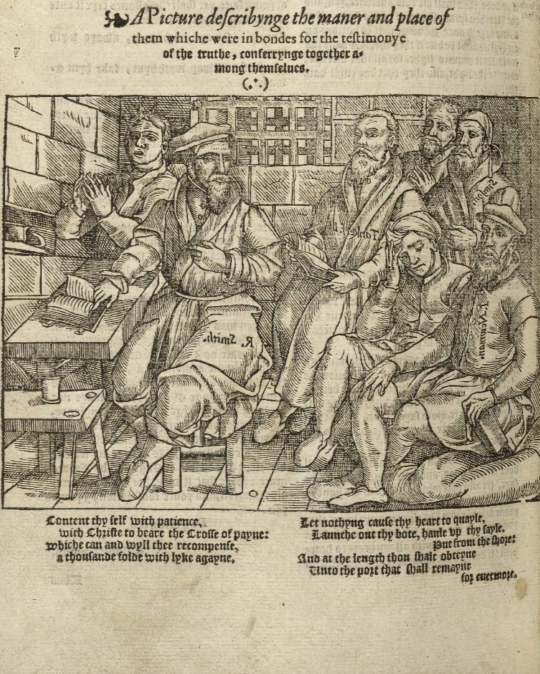
Foxe started to break ties with Norfolk in 1569, moving into his own property on Grub Street; this is around the same time as Norfolk's correspondence with Mary, Queen of Scots, prior to his further arrest and condemnation for his role in the Ridolfi Plot. In his last days at the Tower of London, Norfolk was visited by Foxe, and accompanied him to the scaffold on 02 Jun 1572.

At the start of 1587, Foxe's health began to decline; he wrote to his son Samuel that he was unable eat or sleep, nor continue the work that he had dedicated his life to. He died at his home on 18 Apr, and was buried 2 days later, on 20 Apr, in the chancel of the nearby parish church of St Giles, Cripplegate. His son Samuel erected a monument to his father, which reads in Latin "life is mortal life, hope is immortal life".
#tudor england#tudor history#history#tudor people#tudor#tudors#elizabeth i#mary i#tower of london#Thomas howard#John foxe#foxes book of martyrs
1 note
·
View note